I don't find myself going into the town so often these days, because my daily business takes me to other places in the wider area of Hania. When I recently found myself on one of those rare occasions in the centre, I decided to have a meal at a place I often tell you about, but have never dined at myself.
The original sign for the Marmaritsakis mayirio, establiched in 1950 by Mr Stamatis Marmaritsakis Snr. In place of a telephone number, because not everyone had a telephone in those days, addresses were used instead.
The Agora contains a few μαγειρεία (mayiria), places where you can have a home-cooked meal at a very cheap price. The food served in them is similar to taverna meals, with less emphasis on grilled meat. Mayiria are usually open for lunch rather than dinner, and never on Sundays, as the song says. These are the reasons that make it hard for me to go out for a meal of this type, since I would generally go out at the weekend, and during the week, I cook similar meals to that of mayiria at home for my own family.
Mr Stavros Marmaritsakis has been working in the Agora for 61 years, from the time his father started the business. Over those years, he has seen many people passing by his shop. "There's a lot of sadness in the world," he told me, "but there's also a lot of good. Even when things are bad, they eventually get better."
The opening hours and food choices at the mayiria mark these places out as a kind of worker's diner, a place where you can get a home-cooked meal, or something nourishing if you are a labourer who starts work early in the morning. They are open from quite early, and the first meal they serve in the day is usually offal soup, known all over Greece as πατσά (patsa). Meals in mayiria are always a sit-down affair - there is no rush to eat your lunch here; it's not a place where you just 'grab a bite to eat'.
Mr Stavros in his youth.
The typical customer of a mayirio in Hania these days is usually male, men in their late 30s or older. They may come on their own, or in a small παρέα (parea), in groups of 2-4. Women come in to mayiria too, but not as often as men. This is not surprising, since most women cook the same food at home as the mayiria. This kind of eaterie is frequented by a great variety of people: those who don't cook for themselves or have no one to cook for them, outdoor workers whose job involves heavy duties, out-of-towners who won't have time to cook a meal when they get back home (many people come into the town of Hania from villages, for all sorts of 'urban' jobs ranging from doctor's appointments to banking to shopping), and people who find themselves in town and feel like eating some thing homely.
Mr Stamatis Marmaritsakis Jnr now works in the mayirio with his father. Here he is preparing roast lamb's head.
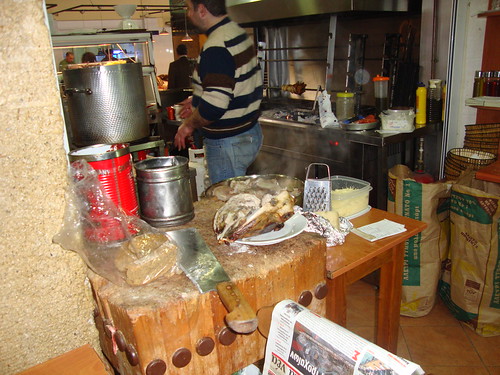
The truth is that mayiria are not often frequented by the younger generation. There are special reasons for this, but the decline of the mayirio is not included among them. It's more a question of what young people are more likely to be doing during the opening hours of a mayirio. At the moment, Greece has a high rate of unemployment (urban centres are sufferng by as much 22%), consisting mainly of young people aged 25 or under, hence this age group is less likely to be going out for a meal during those hours. People leave their home environment and begin living independently after the age of 25 in Greece. It's part of the Greel way of life in Greece to remain at the family home until at least the age of 25. These days, the leaving age of unmarried children is probably higher; the economic crisis doesn't give them much choice.
Simple food in a simple environment
The meals served in the mayiria are most likely what the younger generation is eating at home in any case. And when people land jobs in this day and age, they are more likely to start working on a 'global' basis, which usually means that there is no leisurely lunch break (or siesta, for that matter). Following similar trends in the west, Greeks are likely to bring or buy a sandwich kind of lunch - maybe a piece of pie or a 'wrap' like a souvlaki - something to keep them going until they go home much later in the day to eat their main meal in the late afternoon (which in Greece refers to any part of the day after 3pm and ends at about 6-7pm depending on when the sun goes down). In the recent past of Greece, the typical office worker's day used to stop at about 3 o'clock, which is why the main meal of the day was often 'lunch' and took place between 1-4pm. That has now changed too; most office workers finish work at 4pm or later.
For these reasons, the mayirio's customers are changing, but there is no sign that these places are becoming obsolete. The food they serve is usually of a very high quality, at a very good price (the same meal served at a taverna would cost twice as much as at a mayirio), just the kind of thing you'd expect a caring home-based mama to make on an everyday basis. Although the number of mayiria around town has decreased over the years, they will not disappear altogether due to the increased interest in healthier meal options out of the home.
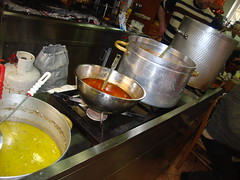
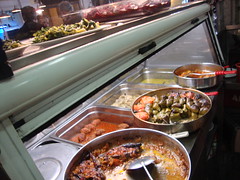 The kitchen of the mayirio: soup pots (the largest contains patsa) and roasting tins.
The kitchen of the mayirio: soup pots (the largest contains patsa) and roasting tins.
The mayiria are also serving more than the function of providing good healthy tasty meals at cheap prices. Their food is timeless - the mayiria are unknowingly acting as the guardians of traditional Greek cuisine, by serving well-known Greek dishes that everyone can recognise instantly. Everyone needs to eat, and more and more people are becoming more and more conscious of what they are eating. The mayiria don't serve 'specialities' in the way that a taverna might claim: the food at mayiria is standard fare, recognisable to all Greeks. Because many mayiria are located close to a central market, they also have access to the freshest ingredients, which is especially necessary if they intend to serve Greece's infamous offal soup, patsa, made of tripe, intestines and various other unmentionables, and 'delicacies' like lamb's head.
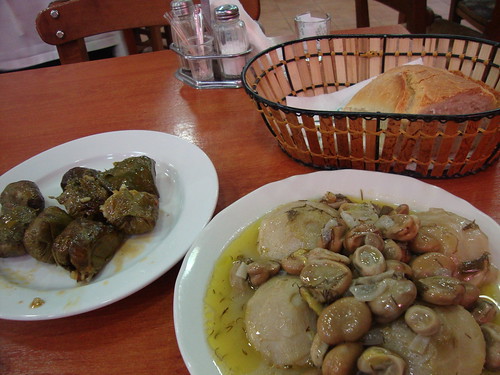
Dolmadakia and agginarokoukia - 6 euro; on the day I visited Marmaritsakis mayirio, the menu choices also included: eggplant imam baldi, soutzoukakia, yemista, beef kokkinisto, fasolada, intestines soup, youvarlakia, boiled meat, gigandes, kefalaki (lambs head - a specialty of the house), horta, beets, fava, and bakaliaro.
When people ask me about where they can get a good meal if they lead very busy lives and work long hours away from home, I always direct them to a mayirio. Souvlaki is a great Greek food too, but it is regarded by Greeks as
ξηροφαγεία - 'dry food', something more
πρόχειρο (roughly made). After a while of eating too many souvlakia, the body will probably crave what is known in Greek as
λαδερά, 'oily', or 'wet' food, the kind of meal served on a plate, not in the hand. You can bet that all meals served at mayiria in the Agora will contain plenty of runny oily sauces, and you'll think you were eating your meal in a homey environment. What's more, it won't burn holes in your pocket.
©All Rights Reserved/Organically cooked. No part of this blog may be reproduced and/or copied by any means without prior consent from Maria Verivaki.


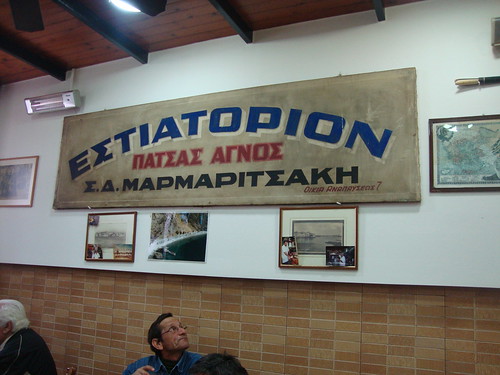
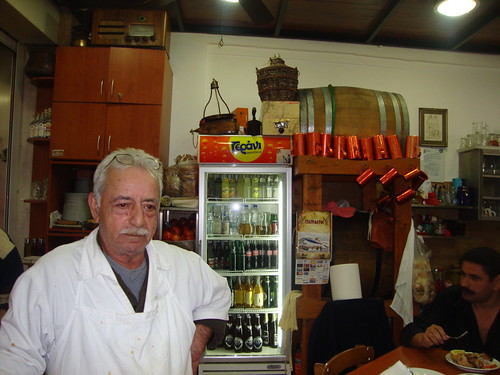
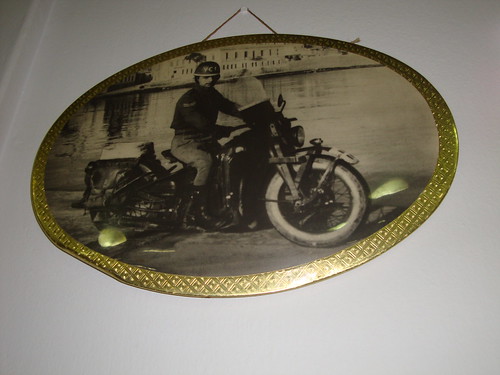
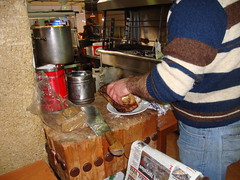
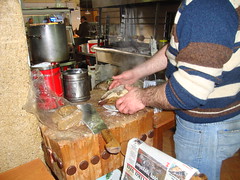
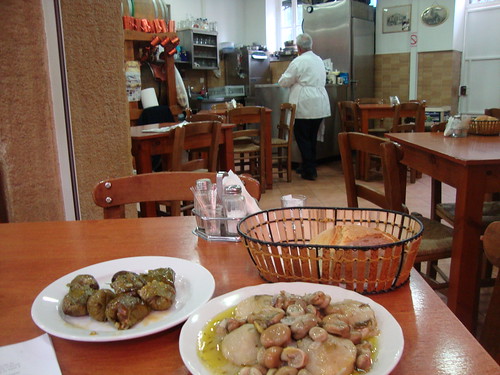




Really cool food! I would kill to be back in Greece hitting up some horio tavernas. Nothing compares! Thanks for letting me live vicariously.
ReplyDeleteThose are perhaps the best places to get great authentic food.
ReplyDeleteIf only I would feel more comfortable in a place like this, being a vegetarian. Than I would really like it there, I imagine.
ReplyDeleteI've often wondered if there are many (secret) vegetarians in Greece/Crete. You did explain a short while ago that you didn't eat meat often, and as far as I know people didn't often have much meat to eat in the past centuries, but I think not eating meat is probably still not very... how to put it... fashionable? (And there probably still isn't any tofu available. You mentioned this quite a while ago, if I remember correctly)
I am also curious about the old picture of mr. Marmaritsakis. I'd like to know its history and it seems (to me) to be framed in an unusual way.
i enjoy these places because even if you dont eat meat, there is still plenty of choice on offer; most of the meals are vegetarian-based (the one i had was totally vegan!)
ReplyDeletei'm glad you asked about the photo: it's a very old-fashioned way of framing photos, popular in the 60s and 70s - no one frames photos in this way now, but in the past, it was a sign of spending money in a special way
Hi Maria. Yes, but you don't mind to be around (dead) meat, I presume, I like to avoid it.
ReplyDeleteThanks about the information about the photo. And have a nice weekend!
Γειά σου φιλενάδα!!! Ίντα κάνεις;;; Καλά σε;;;
ReplyDeleteΜου άνοιξες την όρεξη σήμερα! Τα ήθελα όλα, αλλά ειδικά αυτό το κεφαλάκι....μμμμμ....ξετρελάθηκα! Να'σαι καλά και καλό Πάσχα!!!
Hi Maria, today i sent someone with a bad cold some of your information on Malotira, and then I realised that you might be interested in this: http://www.savenaturalhealth.eu/sign.php
ReplyDeleteApparantly the Europian union wants to (in short) ban medicines made of plants. I have tried to read up a little about it, but this europian directive is somewhat complicated.
I hope you don't mind me sending you this message this way, it is not "on topic' (although Marmaritsakis will probably also serve tsai bounou?)
Any way, Malotira will still grow on the cretan mountains, and i think my biological shop will still carry it as a herbal tea.
thanks very much anni for the information - i think people interested in cretan cuisine will find it useful
ReplyDelete